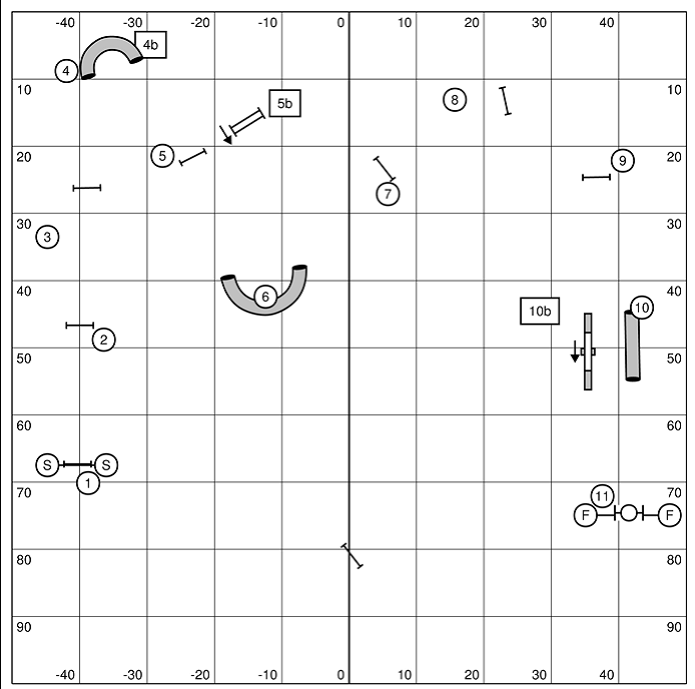Wildcard

The object of Wildcard is to run a short course that contains three “wildcards.” A wildcard is a pair of obstacles placed approximately parallel to each other, five feet apart. One obstacle of the pair is easier and one is more difficult. The easier obstacle is assigned 1 point and the more difficult obstacle is assigned 2 points.
During the briefing, the judge will point out which obstacle of each wildcard is considered the harder of the two, designated as a 2-point obstacle. (Not all dog/handler teams consider double jumps to be more difficult than tunnels, for example.) Thus, it is especially important to attend the briefing for Wildcard.
In the diagram, the 1-point obstacles are designated by the circled numbers and the 2-point obstacles by the squared numbers with “b” appended. On the actual course, the 2-point obstacles will normally have a different color cone than all the other obstacles. This will be explained at the briefing. In this example, entering the tunnel (#4) from the left end would be a 1-point wildcard and entering it from the right (#4b) would be a 2-point wildcard. For the next wildcard, the single bar jump (#5) is the 1-point obstacle and the double jump (#5b) is the 2-point obstacle. Finally, the tunnel (#10) is the 1- point obstacle and the teeter totter (#10b) is the 2-point obstacle of the third wildcard.
In Levels 1/2, the dog must take exactly two 1-point wildcards and one 2-point wildcard. Any other combination will result in an NQ. During the run, you will hear the judge call out “ONE” or “TWO” as you take each wildcard, designating the wildcards accumulated. So, in levels 1/2, your goal is to hear the judge call out “ONE” twice during your run and “TWO” once during your run. Note: In Levels 3/4/5/C, the numbers are reversed, with the dog required to take two 2-point and one 1-point obstacle.
For Levels 1/2, when you walk the course, you should plan which one 2-point obstacle to take, according to the abilities of your dog. What someone else (and the judge) considers the easier obstacle may not be so for you. One possible plan, for example, would consist of taking tunnel #4 (left end), the double jump at wildcard #5 and the tunnel at wildcard #10 (and all the other numbered obstacles in order). But what if when you actually run the course, your dog accidentally enters tunnel #4b (right end)? This would require that you adjust on the fly, and send your dog over the single jump at wildcard #5 instead of the double jump. (Taking both #4b and #5b would result in an NQ due to taking TWO 2-point obstacles instead of just one.) So, during the walk-through, consider these possibilities in case your dog inadvertently takes the wrong wildcard. Finally, you cannot change a wildcard once the dog has touched or committed to the other wildcard of a pair. Doing so would result in an NQ.
Catch Phrase: “ONE 2-pointer and TWO 1-pointers.” (For Levels 1/2) 
Wildcard Reference

Level 1/2 needs two 1-point wildcards and one 2-point wildcard.
Level 3/4/5/C needs one 1-point wildcard and two 2-point wildcards.